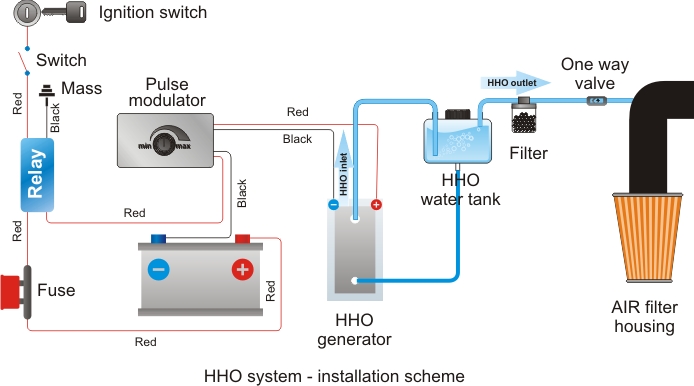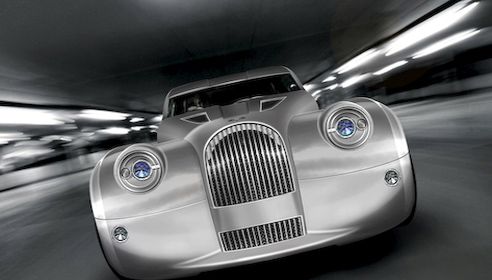
HHO System
HHO system contributes to better work and better use of motor fuel (petrol or diesel) which creates a significant
consumption used in.
This system is composed of:
- Generator
- Water tank
- Potentiometer (pulse modulator)
- Electrical installations
- Hoses, filters, clamps, fuses, and check valve (one-way valve)
- OBD II microcontroller (optional)
 |
HHO system installation scheme
HHO System and HHO generator
Why do we recommend the volume generators below 20 amps
We are a team of professional mechanics and we have launched a series of tests with the HHO generator and the two options in the workshop and installed in vehicles.
1.After brought to power more than 18 or 20 amp generator HHO cells begin to produce steam not HHO gas. 2nd when you install the HHO system in the vehicle, each over 20 amps of power will start straining the alternator, which reduces the quality of the obtained HHO gas than the fuel-mileage.
There is a very simple test you can do with HHO generators to make sure you make the HHO gas or vapor - simply hold down the tubes, which are called "HHO gas out" on a pile of ice formed when water droplets then that money is not the HHO gas.
The process taking HHO gas from water greatly enhanced electrolytes.
Most people currently using KOH electrolyte, though there are new, better things that you can use as a catalyst in your HHO generator.
How HHO generator filled with water and how much water is needed?
HHO generator is readily available reservoir that can be easily filled. In this reservoir is added and the mixture of electrolytes. After the first mix you just add water occasionally.
Why do I need only add water to the HHO system after the initial addition of electrolytes?
KOH electrolyte is not consumed in the electrolytic process, so that if you add more electrolyte mixture becomes more severe and the number of amps will grow. So you should only add distilled water and not the electrolyte.
Where should the generator be installed HHO system?
Anywhere in the space around the engine, the level below the HHO system water tanks to be used, but preferably in a place that will have a constant flow of air that helps the HHO generator to cool down. HHO systems on which we speak are systems in which there is no storage of hydrogen because hydrogen is generated through electrolysis system. Use of these systems has an impact on the decrease in emissions from vehicles.
Is it legal legally installed HHO system in my car?
It depends on the site - and your actual use of HHO generators. Some countries will allow a lot while others have clear limitations. Generally certain rules are designed precisely to prevent the owners from changing the performance of cars and vehicles to save fuel and preserved environment, and even forcing them to use vehicles that waste gas and waste pollute the environment. Today's laws are generally designed to protect the environment and improve the personal and the economy as a whole. However, some people use existing laws to frighten users of hydrogen-on-demand system. The government of each country must be aware of the great benefits of the HHO technology, and you should be aware of these facts.
Can be installed HHO system on the 'inter-cooler engine''?
At this point we do not recommend installing the HHO system except: IF you can be sure there are no corrosive electrolyte or excessive moisture entry.
The study was done by us and other enthusiasts on the occasion of HHO system to determine that no trace amounts of caustic soda (or other electrolytes), which can damage the system, and the accumulated water entering and what effects this can have in the core cooling . A small amount of water vapor in the work that creates HHO system does not accumulate in the engine, due to high temperature engine operation. The "inter-cooler-has an" excess water can accumulate. In addition, we should not try to inject HHO pressure to overcome the positive manifold pressure. Under no circumstances is the CHC must be put under pressure!
This could make the hydrogen bomb. Therefore, this system has nazivava HHO and the "Hydrogen on demand - the system" (HHO on demand), because HHO gas is not stored but used as they stand out in the electrolysis of water.
Is it necessary that the HHO generator off when not in use?
Every HHO system is connected to the ignition switch, every time you turn off the engine, the unit shuts down with him.
Installing the HHO system.
In short, it requires mounting the HHO generator, potentiometer-pulse modulator, fuses, relays filters, check valves, water tanks, switches, installation of hose, and connecting a few cables. We also recommend installing OBD II microcontroller specially designed for vehicles that use HHO as a fuel additive. It tracks the amount of oxygen in the exhaust mixture, the amount of incoming air, temperature and many other variable parameters, determined by the values and sends a signal to the vehicle injection computer optimum fuel mixture. Generator is ideally installed under the hood, but it can be safely and effectively mounted in the trunk. Total time required is approximately 30 minutes to 1 hour for a professional person. To ensure best results and maximum safety to the best professionals to entrust the installation. The system can be removed without damage to the vehicle.
What is the map sensor?
Multiple absolute pressure sensor (MAP) is one of the sensors used in electronically controlled internal combustion engine. Engines that use the MAP sensor is usually "injection" engines because they have controlled fuel injection. MAP sensor provides an opportunity for current information on the electronic pressure control unit (ECU). This is necessary to calculate the control unit density of air, which in turn used to calculate the appropriate fuel flow.
How much water is used HHO system?
Very little. You can drive a lot Sunday without adding water. We advise to add distilled water every week or two to ensure maximum gas production. If you drive an average of about 3,000 miles a month is enough to 1 liter of distilled water.
To accurately calculate the savings?
This is a fairly accurate way:
1st At the gas station, fill the fuel tank.
2nd Record the mileage, before driving away from the pump to fuel only. We will call it a mileage
3rd Drive normally until you notice that the reservoir is less than half full.
4th Fill the tank again (preferably on the same station using the same pump as the pump can be calibrated differently). This time, pay attention to how many gallons it takes to fill the tank and note.
5th Record the mileage again, just as before. We shall call B Mileage
6th A seizure of mileage from the odometer B. This will give you the number of miles you drove since your last charge.
7th Share mileage with the number of gallons needed to fill your tank. This will give you the average fuel consumption of your vehicle.
8th Repeat this test again, this time with the HHO system installed.
9th To determine koilko save, subtract the average fuel economy with HHO system than the original fuel per 100 km.
How to maintain the HHO system?
Make sure the engine HHO generator is turned off and cooled before servicing. For extra safety, also remove the clamps on the battery before servicing. At the same time you can check all hoses and electrical wiring to complete HHO system for a good connection. Check water level every fill gas, keep it at about 5 cm from the lid.
Does HHO injection damage my car?
For this outcome there is a possibility. On the contrary HHO engine will improve because it cleaned every day. Nesagorele matter that has accumulated will be removed, reducing the wear and there is an increase performance.
Will the HHO system loaded battery?
HHO system requires very little energy to work: 10 - 15 amps, about the same as audio device. HHO system requires very little energy to work: 10 - 15 amps, about the same as audio device
Emissions?
Emissions are largely the result nesagorevanja fuel. As the fuel burns completely far emissions are reduced. The result is the splitting of water to create water vapor and oxygen, two totally harmless substances that can help to protect the environment and reduce pollution incurred during fossil fuel .. This significant reduction in emissions to help reduce the harmful effects of toxic pollution and global warming.
Increased performance and changes in work?
HHO system with most of your primary fuel will be fully utilized, and improve overall ujednačiće driving and operation of the car. Almost immediately notices a significant reduction in engine noise, and complete combustion which helps to correct the motor cycle .. For a period of one month from the engine will remove carbon deposits caused by unburned fuel built, and further increase performance and reduce emissions. The valves and pistons, etc., will be free and unhindered to do, thus reducing wear. The acceleration and horsepower will increase and the engine will operate more efficiently.
What is the difference between HHO and hydrogen?
HHO contains one part oxygen (such as hydrogen and two parts of course), as opposed to pure hydrogen. HHO is significantly more combustible than hydrogen, thanks to the presence of oxygen in perfect proportion. Pure hydrogen is much more expensive to exploit. The advantage of the HHO gas because it is easy and economical to make.
Is the use of HHO system really a viable solution for high fuel prices?
Large oil companies have done all they can to discredit the technology over the years.Chemists are paid to point out that the equation does not work, given the fact that the technical needs more energy to split water into hydrogen and oxygen (HHO) in relation to what is obtained from the combustion of hydrogen.
While this is true, the fact is that your car is constantly charging the battery via the alternator. Something that happens while the engine is running, regardless of whether the HHO system installed. Natural mechanical engine power is what really gives you energy HHO system by constantly charges the battery of the vehicle. The energy gained by burning hydrogen and oxygen (hydroxyl) in the combustion chamber is a pure net profit.
Will the HHO system cause rust on the engine?
The water passes naturally through the fuel and the engine and if you look at the exhaust, while the car is, you can see droplets of water and steam that comes out as a result of fuel combustion and condensation.
Hidrogen as a fuel
If you have an interest in the topic of hydrogen as a fuel, then you should review the following information.
For many years, scientists and researchers trying to find an alternative source of fuel energy for cars and get the final results after many years of study. The fact is that the car will not run without fuel. But the hydrogen fuel system, you can increase the traveled kilomteražu while lower costs for gasoline.
Car companies and hundreds of researchers offer a very efficient solution of hydrogen systems. What's it all about? If you own a car, it's time to use hydrogen fuel because it can save lots of money. All you have to do is make install HHO system. After that, your car will have added power If you think that the system costs a lot, you're wrong. Installation is also not a big problem. If you want long lasting and easily maintained engine to install the HHO system in your car.
The search for savings on fuel for the car is completed. Firstly, your gasoline expenses will decrease. Second, you can help in improving the current state of the environment.
Engine will broadcast large amounts of greenhouse gases and thus reduce environmental pollution. Hydrogen from water has a role to ensure the car more energy and reduce fuel consumption.
This results in cleaner emissions from the engine because the byproducts of HHO system water and oxygen. But the internal combustion engine, the car gives the carbon emissions and even carbon deposits. If you want to help in solving the current problem of global warming, install a HHO system. Global warming and very high fuel prices are quite alarming and these are the reasons why many car owners today want to use HHO system. Car owners who are now using hydrogen as fuel, enjoy a significant reduction in fuel costs.
na početak strane
HHO as a supplement to fuel mixture
Igniting the HHO mixture will release energy (a proper mix can reach temperatures of 2800 degrees C, steel melts at 1500 degrees C) and cause the two gases to re-combine producing water vapor. It's an exothermic reaction. If properly harnessed, that heat energy will do work for you the same way a gasoline/air mixture does when ignited in your car's engine. It is the same method of technical application, just different fuels. So through electrolysis, water acts as an energy storage medium. Where is energy stored and when? The energy is stored during the electrolysis process at the instant the H2O molecule is split and the HHO gases form. In your engine cylinder, on ignition, the energy is released to do work, resulting in increased combustion efficiency. Note, at no point can water (H2O) "burn" for fuel. It's just not chemically possible. Why? It is simple. When hydrogen and oxygen have formed an H2O molecule, then useful exothermic energy is depleted and the molecule becomes relatively (chemically) stable. In such case, there's no way for it (the water molecule) to form an additional exothermic reaction using more oxygen because hydrogen is already oxygen-bonded. Since the hydrogen is trapped and not available for additional exothermic reaction, water is simply useless as a fuel energy source to your car engine. Water can be further oxidized (i.e. hydrogen peroxide, H2O2) but the reaction required is a net consumer of energy (endothermic reaction) as opposed to one that releases energy (exothermic reaction). The fact is that your car can run on a mixture of gasoline and HHO gas as a hybrid fuel. It supplements and improves combustion in your engine producing much cleaner vehicle exhaust emissions (very good for the environment). The higher the percentage of HHO used by your car's engine to generate power, the less gasoline fuel it needs to burn. The less gasoline it burns, the more money you save. However, in a hybrid fuel application the HHO itself only adds an insignificant amount of kinetic energy toward piston movement. HHO combustion helps your engine in a different way.
How does it help? What does HHO actually do?
HHO primarily functions as a very effective and cheap fuel combustion enhancement additive. It has the effect of increasing your engine's ability to draw more power from each gallon of gasoline (combustion efficiency). To understand this, we need to look closely at engine fuel combustion, air/fuel ratios and fuel configuration. Combustion and air/fuel ratio
Combustion and air/fuel ratio
Gasoline from your fuel tank is broken into tiny droplets, mixed with atmospheric oxygen (air) and drawn by vacuum into your engine cylinders (for fuel injection systems, fuel injectors break-up and spray gasoline directly into the cylinders). The piston compresses this mixture and when ignited by your sparkplug, the explosion (combustion) supplies power to your car. One of the variables that determines how much energy (power) is extracted from the combustion reaction is the air/fuel ratio (ratio of gasoline to air). Too much air (or too little fuel) produces a "lean" fuel mixture. Power output may suffer in this condition because the engine isn't getting enough fuel to burn. Too much fuel (or too little air) produces a "rich" fuel mixture. In extreme conditions, this can also cause power loss because there's not sufficient oxygen in the cylinder to burn enough of the droplets to sustain a useful (power generating) reaction. A rich condition also wastes fuel because unburned droplets are thrown away with the exhaust. Car manufacturers historically have tuned the air/fuel ratio for optimum power but also tune it heavily to the rich side to accommodate fluctuations in atmospheric oxygen quality/quantity conditions (i.e. altitude, temperature, moisture content, etc..). This has helped engines maintain a smooth and consistent power curve over a wide range of operating conditions. However, the droplets that aren't burned as a result of the rich ratio setting (read as, gasoline not converted into engine power) to this day, are still thrown away as exhaust (in the 1970's the EPA, horrified by this practice and it's environmental impact, mandated tailpipe emission controls = catalytic converters to finish burning the unburned throw-away fuel). This means, today, your car engine throws away a huge amount of fuel as a hedge against losing power due to changing environmental conditions as you travel. You pay for that hedge every time you turn the key. Manufacturers have allowed the car driving public to drive their cars for decades with this fairly expensive trade-off in place, completely unaware of the money being throwing away.
Fuel Configuration
Another variable that affects combustion efficiency is fuel configuration. This is difficult to control and is a way of understanding how much fuel is actually available for combustion due to fuel unit size. For instance, the smaller is the unit of fuel, the faster and more completely is the combustion reaction. In the cylinder at ignition time, the exothermic reaction fans out from the sparkplug as a flame front or wave. Each gasoline droplet ignites in turn from the heat generated by a neighboring droplet. This sustains the reaction as long as oxygen is present. However, it is only the surface of the droplet that burns because it's the surface that is in contact with the cylinder's oxygen. The gasoline in the droplet's interior must wait for the reaction to reach it (like a charcoal briquette that burns from the outside in). Meanwhile, traveling around the sides of the droplet (where there's oxygen), the reaction is heating and igniting neighboring droplets, propagating the flame front. A droplet may or may not burn completely, depending on it's size. Larger droplets take longer to burn. In addition, this reduces the velocity of the flame front because it takes longer for the reaction to heat neighboring droplets to their point of ignition (ignition propagation delay). Here's a somewhat familiar example to illustrate. Throw a small piece of coal on a campfire and note how long it takes to ignite and burn. Then, take another piece, the same size and weight, but first crush it into fine powder, then toss the powder into the fire (be careful). Of course, it burns literally, in a flash because the fuel that was previously unavailable (on the interior) is now exposed to oxygen and ready for combustion. That flash was the movement of the flame front through the powder as each particle ignited and burned. This illustrates how fuel configuration affects combustion. Smaller pieces burn faster, collectively hotter and speed flame propagation. The gasoline droplet in your cylinder is a different type of fuel, but it's governed by the same laws of matter. Big units of fuel take longer to burn completely. Smaller units burn faster, more completely.
Enter HHO
HHO je izuzetno efikаsаn Enter HHO HHO is extremely efficient in terms of fuel configuration. As a nascent gas mixture, it's hydrogen (and oxygen) exist as tiny independent clusters of no more than two atoms per combustible unit (diatomic molecules of H2, O2). Comparatively, a gasoline droplet is monstrously large (many thousands of very large hydrocarbon molecules). This diatomic configuration of HHO results in extremely efficient combustion because the H2 and O2 molecules interact directly without any ignition propagation delays due to surface travel time of the reaction. Unlike a gasoline/air fuel mix, there are no mammoth globs (droplets) that burn from one side to the other, slowing the ignition flame front. HHO's ignition propagation is immediate and direct (atom to atom). When HHO is mixed with your gasoline/air fuel it's hydrogen surrounds the gasoline droplets. On ignition, it's flame front flashes through the cylinder at a much higher velocity than in ordinary gasoline/air combustion. The heat and pressure wave HHO generates crushes and fragments the gasoline droplets, exposing fuel from their interior to oxygen and the combustion reaction. This effectively enriches the air/fuel ratio since more fuel is now available to burn. Simultaneously, the HHO flame front ignites the crushed fragments thereby releasing more of their energy, more quickly -- the same way crushed coal powder liberates its energy more quickly than that same coal as a single large piece (see "Fuel Configuration" above). In addition, since HHO is dispersed throughout the cylinder, the gasoline/air mixture no longer waits for it's own slow, sequential droplet to droplet ignition process. HHO, because of it's very high combustion velocity, detonates all the "crushed" fuel virtually at once (behaving as an explosive primer). The additionally exposed and burning fuel applies more pressure on the piston in a shorter time interval. Most importantly, the reaction burns and extracts power from fuel that previously would have been thrown away with the exhaust. More precisely, droplet fragmentation makes more gasoline fuel (or diesel fuel) available for combustion to convert into power, without drawing more fuel from your gas tank. Therefore HHO increases gas mileage by forcing your engine to burn gasoline more efficiently and completely, thus delivering more work from each gallon you purchase. Increasing the amount of cylinder HHO means an increase in droplet fragmentation = higher combustion efficiency. In other words, HHO delivers it's primary benefit by modifying the engine's fuel, not by acting as an engine fuel. It is very important distinction.
Hibrid cars
HHO - Mischaracterized and Misunderstood
So, HHO is a powerful combustion enhancer. Some researchers are even looking for ways to produce a car that runs 100% on it's own HHO, generated from water on-board the vehicle. This is very good for the environment, but very bad for oil companies. It would represent a HUGE shift in global economic power, if nearly free and clean energy became available to anyone/everyone.
So where is the problem?
Why do some see the application of this old technology as some sort of scam or hustle? There are several misconceptions and a lot of discussion where people are simply misinformed and talking at cross purposes.
The chief problem is one of education and terminology.
The way in which water can be used to supplement power to your engine (with HHO gas) is simply communicated very poorly to the public at large. Described by some as a way for cars to "run on water", or "burn water for gas" cause most people to instinctively view such claims with skepticism -- and rightfully so. As you've read now to this point, what reaches your engine for combustion is not water (it's HHO gas).
Some other people are doubtful of HHO as an effective fuel booster/enhancer. For them, entertaining the idea that something derived from water can be used this way is difficult. Why? It may be they suffer from a type of cultural, historical and educational (or lack thereof) hypnosis.
For the last century our main source of power (especially for transportation) has been fossil fuels (oil, coal, etc...).
It's comparatively easy to see that gasoline is flammable (as with most fossil fuels).
Whether in liquid or air/fuel mixture form, it's violently and readily reactive when exposed to the slightest spark.
Not so with water. If you set an acetylene torch to water, the most it will do is boil and convert to steam.
It just doesn't seem to make sense (to some) that water, a substance critical to your engine's cooling system, can also have an important role in conveying useful energy to that same engine for power enhancement. It was before doing some researches and getting the real facts.
To be sure, vehicular application of electrolysis technology is still maturing and may never be ready for use in a distributed storage infrastructure such as gas stations because HHO compression would be involved. In fact, since many of you have been asking, we'll mention that compressing and storing hydrogen gas (especially HHO in any form), is *** EXTREMELY *** DANGEROUS (we strongly recommend against attempting to do so) especially at home.
This can't be overstressed because HHO is, by it's very nature, unstable, difficult to store (the H2 molecule is so tiny, it can actually migrate through the walls of metal containers) and is extraordinarily predisposed to explosive combustion because of its oxygen component. When HHO forms, it forms with everything needed for a perfectly balanced (and violent) exothermic reaction. All it needs is a little thermal push. Any thermal energy source that brings it to it's ignition temperature will do it. Remember, gasses heat as they're compressed.
This adds thermal energy. Compression also has the effect of lowering the auto ignition temperature. In addition, the presence of oxygen further lowers the reaction threshold. This means compressing HHO is a sure recipe for disaster. Make no mistake. Lethal results are quite possible.
Burning at 2800 degrees C, any significant compressed amount, ignited, will rip most pressure vessels apart like tissue paper, resulting in near-molten flying shrapnel. The human body makes a very poor absorber of this kind of punishment (not to mention the fire danger).
Compressing HHO is similar to trying to sucessfully make nitro glycerin in your kitchen sink. There are too many variables to control. Any one mistake (wrong temperature or a random spark) could be fatal for you. We have to repeat it once more, we strongly recommend against attempting to compress and/or store HHO gas.
The HHO on-demand technique for your car consumes HHO gas as it's produced so no storage is required. This is very important safety fact.
The most important problem and limiting observation for a 100% vehicular HHO on-demand application concerns overall efficiency and understanding it's effect. Current electrolysis methods are inefficient (25 - 50% efficiency is typical). In addition, overall system efficiency, defined as the amount of power required to generate HHO compared to the amount of energy it delivers under combustion will always be significantly less than 100% (there are energy losses due to heat energy transfer, electrolytic conductivity/resistance, etc...).
There is no way known to counter those losses by extracting more energy from HHO (through combustion) than has been stored electrically by your car's alternator and battery (using on-board water electrolysis). According to the 1st and 2nd law of thermodynamics, it's impossible. If it were possible, your engine could run on 100% HHO by endlessly creating and consuming it's own fuel for propulsion (the very definition of a perpetual motion machine).
Not possible by any physics we understand today. However, for a given hybrid fuel application, your objective is to produce just enough HHO to increase and maximize your engine's overall combustion efficiency.
Though HHO delivers it's own combustion energy at a loss, you make-up for that loss by increasing the combustion efficiency of your engine's gasoline/air fuel mixture. In fact, as mentioned before, normal engine combustion is so inefficient (20 - 30 percent max) even a relatively small amount of HHO is able to deliver sizeable overall net gains to engine output. That's where the real savings are for any HHO on-demand system that you can build and install today. In other words, again, HHO can boost your car's miles per gallon (MPG) by making it a more efficient gasoline engine.
The bottom line: Will it work in your car?
This question really has two practical parts.
The first is: "Can my car be made to produce HHO?". If you currently use gasoline in your car as a fuel, the answer is an absolute, unconditional, "Yes!". All you really need is your battery, some hardware odds and ends and a conversion guidebook. With those pre-requisites in place, you can initiate and sustain water electrolysis to produce HHO.
The second question, "Will my car utilize the HHO fuel once it's produced and delivered to my engine?". Actually the better question is how much of a savings will you realize using hybrid gasoline + HHO for fuel?. Someone who has added the technology to your make and model vehicle can best tell you what to expect, based on their experience. That's why we think support is so important for the guidebooks.
However, we spoke with several parties using the techniques on different vehicles. From trucks to compacts each user has realized anywhere from 10 to 40 percent savings, initially. These are very respectable performance for a little container of water, some wire, metal fittings and a couple of lengths of rubber tubing. Tuning and scaling can bring much higher returns.
OBD II micro controller
OBD II microcontroller - monitoring the level of oxygen in the exhaust mixture, the amount of incoming air, temperature, and many other variable parameters, determined by the values and sends a signal to the vehicle injection computer optimum fuel mixture.
It has the latest hardware specifically designed for engines that use HHO as a fuel additive.
When HHO is used as additional fuel OBD II microcontroller will adjust fuel delivery andinjection timing for optimal fuel consumption.
The microcontroller is an extremely sophisticated and has a quick response andcommunication with the vehicle computer (ECU) made via the serial input and outputports on the OBD II vehicle.
It is compatible with all engines (petrol and diesel) with OBD II port with and withoutturbochargers.
Site search
Sign up for news
News
Video chanel
Visit our video channel and find the answers to all your questions.
Technicians, follow the missed trainings.
Action - spark plugs "Brisk" a gift
With each built-in Autogas device we give a set of "BRISK SILVER" spark plugsfor LPG/CNG.
Sign up for free training
All service personnel interested in training for installation and configuration of computer unit of the new generation, we provide free training ...
Find us on Facebook
Interesting from the world of cars
 Details...
Details...














